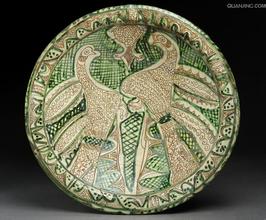From paired heads, we move to single heads of women
現(xiàn)在我們從夫妻頭像轉(zhuǎn)到單獨(dú)的女性頭像上來(lái)
starting with this dish marked with the workshop
首先從這個(gè)印有大概可追溯到1519年的
of Mastro Giorgio Andreoli Gubbio of
喬治·安德烈?jiàn)W利·古比奧大師的
circa 1519
作坊的盤(pán)子看起
This bowl is the earliest in a group of pieces in the exhibition
這只碗是本次展覽最早展出的一批
which are traditionally known as Bella Donna
傳統(tǒng)上被稱為美麗的女士
The group comprises a category of
這一批包括一種
maiolica dishes bearing female heads
印有女性頭像
accompanied by a name label and an adjective
和由形容詞 如:美麗的
such as "bella", beautiful
加名字組成標(biāo)簽的馬爵利卡陶餐盤(pán)

These pieces were made in a number of different centres
這些瓷器出產(chǎn)于許多不同的制陶中心
and have been classed since the 18th century as love gifts
并從18世紀(jì)開(kāi)始進(jìn)行了歸類(lèi)
given by a man to his betrothed
作為男性贈(zèng)給與之有婚約的女性的定情之物
they continue to intrigue scholars
它們?nèi)晕鴮W(xué)者
You can read the latest contribution by Luke Syson
你們可以閱讀由魯克·希森
to this long debate
最近為本展覽畫(huà)冊(cè)中的
in the catalogue to the show
冗長(zhǎng)的辯論所寫(xiě)的文字
which concludes that the women depicted
其中總結(jié)了所描繪的女性
and the ceramic pieces themselves
以及瓷器本身
are unequivocally objects of love
是明確的愛(ài)情信物
The heads are usually
這些頭像通常被刻畫(huà)成
stereotyped and stylized
比較刻板而程式化的形象
so as to make it hazardous to view them as portraits
從而避免使其與肖像畫(huà)混為一談
but the names are thought to refer to real women
但它們的名字被認(rèn)為是真實(shí)的女性的名字
to whom the pieces were given as flattering tributes
這些瓷器是作為討好她們的禮物
Support for this interpretation
支持這種說(shuō)法的解釋
comes from a poem
來(lái)源于安德里亞納·肯蓋爾
written by Adriana da Conquelle in 1557
于1557年
addressed to a potter of Deruta
寫(xiě)給德魯特的一位制陶工人的詩(shī)
which takes the form of praise for
這首詩(shī)采用的是通過(guò)贊美他的故鄉(xiāng)圖爾迪
the women of his native city, Turdi
來(lái)恭維女性的形式而寫(xiě)的
The poem makes explicit
該詩(shī)歌非常明確地表明了
the link between living women
馬爵利卡陶瓷上面所描繪的是
and female heads on maiolica
當(dāng)時(shí)仍在世的女性頭像
The names you find on these pieces
你們?cè)谶@些瓷器上面看到的名字
often appear classical or literary
經(jīng)常出現(xiàn)在經(jīng)典名著或文學(xué)作品中
but we need to remember that such names were fashionable
但我們需要記住這些名字在15世紀(jì)末期
in the late 15th and early 16th centuries
和16世紀(jì)早期的
at a certain level of society
某個(gè)社會(huì)階層是非常時(shí)髦的
The name "Beautiful Polyxena"
這只碗中描繪的
above the profile of a young woman
一位年輕女子的側(cè)面圖的上方所記載的
on this bowl is an Italian version of Polyxena, the daughter of
美麗的波利希娜是意大利版的波利希娜
King Priam of Troy
她是特洛伊的國(guó)王普利安的女兒
who was sacrificed to appease the ghost
她犧牲了自己
of Achilles in the stories
以此來(lái)使阿基里斯的靈魂得到安息
told in Ovid's metamorphosis
這是奧維德的變形記中所講述的故事
With these classical associations, the name suggests
通過(guò)與這些古典名著的聯(lián)系 這個(gè)名字揭示了
a certain level of literary
某個(gè)社會(huì)統(tǒng)治精英階層內(nèi)的文學(xué)
and classical culture within a social elite
和經(jīng)典文化的某個(gè)層次



